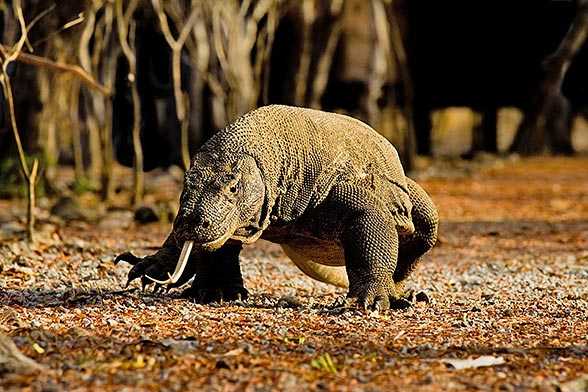The Komodo Dragon, A Natural Born Killer

It’s reassuring to know that nature still has the power to surprise us, and the Komodo dragon continues to do that. From its relatively recent discovery – by Europeans, at any rate - in 1910 to the latest debate on this lean, keen killing machine, the Komodo never ceases to confound and amaze.
It’s the largest living lizard, growing up to ten feet in length. It has about 60 serrated teeth, each up to 2.5 cm (1 in) long, which are constantly replaced as they wear down. And they’re powerful enough to bring down even large animals like deer and wild pigs. The established theory was that komodo dragons’ saliva contained 58 different species of bacteria, 93% of which were classified as pathogenic. One bite from the dragon was enough to infect its prey and cause a long lingering death, if the bite itself didn’t kill it.
Komodo Dragons Eating a Wild Buffalo
But the news is that the Komodo, far from attacking prey with poor dental hygiene, actually secretes a deadly poison in well-developed venom glands. The venom it exudes contains at least two potent toxins: one lowers its victim’s blood pressure, sending it hurtling into a state of shock; the other contains powerful anti-coagulants, preventing wounds from drying up. Like something out of a horror film, the hapless prey quickly descends into torpor and dies.
A Komodo Dragon Heating in the Sun
Why in this day and age has it taken us so long to come to this conclusion? Well, numbers of komodo dragons are severely depleted for well-rehearsed reasons – its natural habitat is under threat from both man and nature - so it’s thought there are only around 3,000 to 5,000 left in the wild. And though they’re a fascinating and popular zoo exhibit, they don’t do well in captivity. So it’s not just a case of dissecting one to see how it works.
But biologist Brian Fry had the opportunity to do just this when two specimens died unexpectedly in a Singapore zoo and his latest study was published in the Proceedings of the National Academy of Science.
And what’s the significance of this? Well, the better we understand these fascinating lizards, the more chance we have of creating the right environments for it to survive extinction. And the lessons we can learn from it could assist new advances in modern medicine.
We’re learning, but whether we learn soon enough for the komodo dragon is as yet uncertain.